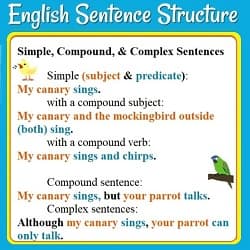Learn to Write English: 5 Top Strategies
Why learn to write English? You have ideas that are worth sharing. Take a little time to learn how to share them clearly in English.
Many of the principles of good writing are the same in any language.
Even so, to make your point as understandable as possible, you need to know the way English speakers organize and present their ideas in writing.
Here are five strategies that can help you learn to write English to get the results you’re looking for.
1. Think Before You Write
Start with the basics: Why are you writing? Have something worth saying and be sure of the main thoughts you want to communicate.
Then think about the people you’re writing for (your audience.) What do they already know about your topic? Do they have any misunderstandings or biases you ant to clear up?
(If you need to persuade them to change what they think, be sure to find some common ground first. They need a reason to trust you before they will listen.)
What do you want them to know, believe, or do after they finish reading?
Once you know the who and the why, consider the ‘how.’
What’s the best way to arrange your thoughts so they will be easy to follow? What examples and evidence can you give to back up each of your points? You might make an informal outline, with room for examples after each point or argument. If you don’t like outlines, try a mind map. (There are several free mind-mapping programs online.)
It doesn’t matter what method you use, but be sure to have a skeleton plan to which you can attach each thought. Plan your transitions as well. You need to connect the pieces of your argument or main idea so your audience can see where you are leading them.
2. Get Organized-- & Write!
How can you organize your main ideas and the evidence to support them most effectively?
A clear structure makes your ideas easy to understand. Use your outline or mind map! You need to introduce your main idea early. Then provide the examples and details that make it clear. Finally, your conclusion should summarize the main points for your readers to remember (or the action they should take).
You may not want to write the introduction first. Sometimes it’s easier once you’ve already written most of your first draft. Whatever order you write in, go back and tie it together better once you have it written.
Learn how to show the connections between your thoughts and make clear transitions between them. You might want to practice transition words.
Also, consider learning less familiar transition and linking words used in academic writing.
3. Revision Is Not Optional!
Good writers go through their writing several times. They often read it out loud to find out if they can hear something that is unclear or unfinished. (It’s easy to miss some things while reading your work.)
(A word of assurance for anyone facing the TOEFL or IELTS essay tests. The examiners do understand that you don’t have time to do a proper revision. You are showing them that you can write a quick rough draft on a topic you could not prepare for in advance. They don’t expect perfect, polished writing.
If your teacher or boss gives you a writing assignment, it’s very different. They do expect revision and proofreading!)

Look at the way you have organized your paper:
1. !s there an introduction explaining your main idea and purpose in writing? Could you add a question or quick story to ‘hook’ your readers and encourage them to want to keep reading?
2. Does the body of your essay, proposal, etc. give convincing evidence for each of your points? Compare with the outline or mind map you made at the beginning. Did you forget anything important?
3. Does your writing make sense and flow well from one thought to the next? Are transitions clear so your readers don’t have to guess where you’re taking them?
4. Does your conclusion summarize your main ideas? Have you connected any loose ends or unfinished arguments?
5. Check your word choices. Consider word connotations. What are the best words to express your message? Are any words unclear or misleading?
Aim to cut any unnecessary words or phrases. (People are busy!) Trying to impress people with big words or long sentences doesn’t work!
6. Then go through that second (or third) draft one more time. Have you explained everything as simply as possible?
Are there any changes you could make so your writing would be easier to read?
4. Proofreading: Double-check the ‘Mechanics’
After revising, go through again and proofread. Check your grammar, spelling, capital use, and punctuation. (Use spelling and grammar checkers. Also read what you have written aloud.)
Checkers are imperfect. They also cannot catch incorrect word use. (If you write ‘there’ when you mean ‘their’, or ‘it’s’ instead of ‘its’, a spell checker sees a correct spelling. It’s only the meaning that is incorrect.)
Know basic English sentence structure,* and check to make sure your subjects and verbs agree.
Writing is more interesting when you vary your sentence structures and use synonyms rather than repeating a word often. However, it’s more important for your writing to make sense! Don’t use words or structures you aren’t sure about.
You might want to use the Revision and Proofreading Checklist. (The last section on Compound & Complex Sentences is optional. It should help if you have problems with sentence fragments, run-ons, or commas.)
You can also practice proofreading (& summarizing) on the Proofreading Practice page.
* If you are not comfortable with English grammar, consider reviewing it. Check out compound sentences or complex sentences if the structures are different in your first language.
(What about Tense formation or Phrasal verb use-- which ‘prepositions’ need to follow certain verbs?)
5. Allow Extra Time Until You Learn to Write English Well.
It will get easier to write in English as you use it more. Until then, reduce stress by allowing plenty of time for English writing assignments.
Bonus (not exactly a ‘strategy’):
Consider the Differences Between Speech & Writing
Writing has some disadvantages compared to speech. People cannot watch your facial expressions and gestures. They can’t hear your tone of voice, word stress, or speech rhythms. Those clues communicate more than the actual words and word order in spoken language.
Besides that, when you speak your hearers can ask questions if something is unclear. Their feedback lets you know how well they understand your message. If they misunderstand part of it or react unfavorably, you can explain a little more to help them get your point.
So as you learn to write English better, focus on making your message clear the first time since your readers are not in the room with you. (Instant messaging helps, but it’s still a problem with most writing.)
Writing also has some advantages. Writers have time to organize their thoughts. They can revise them for clearer expression-- not possible in conversation. Besides, your readers have time to absorb what you say. They can look up unfamiliar words or re-read if they didn’t understand at first.
Good writing makes full use of these advantages. Think about what you want to say and the questions your readers may have. Then express your thoughts in an order that is easy to follow from point to point. Use good punctuation to show some of the pauses (commas) and full stops (periods) of speech.
Paragraphs (and chapters, in long texts) show transitions to new ideas. Paragraphs are also important for breaking up text. (Have you ever tried to read a wall of text without breaks? It is so easy for the eyes-- and mind-- to lose their place and get distracted!)
So, organize your thoughts and choose your words with care. What you write may influence a reader’s life more than you expect!
More English Writing Resources
Some special rules apply to academic writing. It is more formal and precise. There are special rules for showing the sources of your information and for avoiding plagiarism.
Communicating science is another specialized field-- but with the purpose of making science clear to the general public. So it avoids the technical academic vocabulary that is appropriate when scientists publish their results for other scientists.
Essay Organization discusses types of essays and the sections that every essay should include.
For examples of essay planning and writing, see A TOEFL or IELTS Essay Example. English Essay Writing Practice explains essay requirements and has practice exercises.
Check out the Virtual Writing Tutor. It is a free grammar checker that specializes in feedback to help non-native English speakers learn to write English better. (It even suggests you can use it together with Grammarly, which sounds like an excellent plan to me.)
If you write in English very often, check out this list of useful online writing tools and how to use them. Most are free or have a free version. They can help you brainstorm or save ideas, proofread your writing for correctness and readability, and do a lot more. I've used several of them, and especially recommend the Hemingway App.
Didn't find what you
needed? Explain what you want in the search box below.
(For example, cognates, past tense practice, or 'get along with.') Click to see the related pages on EnglishHints.
| site search by freefind | advanced |







